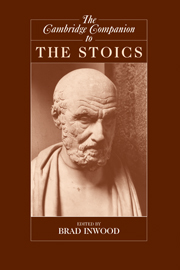Book contents
- Frontmatter
- Introduction
- 1 The School, from Zeno to Arius Didymus
- 2 The School in the Roman Imperial Period
- 3 Stoic Epistemology
- 4 Logic
- 5 Stoic Natural Philosophy (Physics and Cosmology)
- 6 Stoic Theology
- 7 Stoic Determinism
- 8 Stoic Metaphysics
- 9 Stoic Ethics
- 10 Stoic Moral Psychology
- 11 Stoicism and Medicine
- 12 The Stoic Contribution to Traditional Grammar
- 13 The Stoics and the Astronomical Sciences
- 14 Stoic Naturalism and Its Critics
- 15 Stoicism in the Philosophical Tradition
- Bibliography
- List of Primary Works
- Index
1 - The School, from Zeno to Arius Didymus
Published online by Cambridge University Press: 28 May 2006
- Frontmatter
- Introduction
- 1 The School, from Zeno to Arius Didymus
- 2 The School in the Roman Imperial Period
- 3 Stoic Epistemology
- 4 Logic
- 5 Stoic Natural Philosophy (Physics and Cosmology)
- 6 Stoic Theology
- 7 Stoic Determinism
- 8 Stoic Metaphysics
- 9 Stoic Ethics
- 10 Stoic Moral Psychology
- 11 Stoicism and Medicine
- 12 The Stoic Contribution to Traditional Grammar
- 13 The Stoics and the Astronomical Sciences
- 14 Stoic Naturalism and Its Critics
- 15 Stoicism in the Philosophical Tradition
- Bibliography
- List of Primary Works
- Index
Summary
PHASES
The history of the Stoic school is conventionally divided into three phases:
Early Stoicism: from Zeno's foundation of the school, c. 300, to the late second century b.c.: the period which includes the headship of the greatest Stoic of them all, Chrysippus
Middle Stoicism: the era of Panaetius and Posidonius
Roman Stoicism: the Roman Imperial period, dominated by Seneca, Epictetus, and Marcus Aurelius
Although the Stoic tradition’s continuity is at least as important as any resolution into distinct phases, the traditional divisions do reflect key changes which no school history can afford to ignore. The following account will, in fact, assume a rough division into five phases, despite acknowledgment of extensive overlaps between them:
the first generation
the era of the early Athenian scholarchs
the Platonising phase (‘Middle Stoicism’)
the first century b.c. decentralisation
the Imperial phase
The primary ground for separating these is that each represents, to some extent, a different perspective on what it is to be a Stoic – that is, on what allegiances and commitments are entailed by the chosen label.
- Type
- Chapter
- Information
- The Cambridge Companion to the Stoics , pp. 7 - 32Publisher: Cambridge University PressPrint publication year: 2003
- 37
- Cited by



